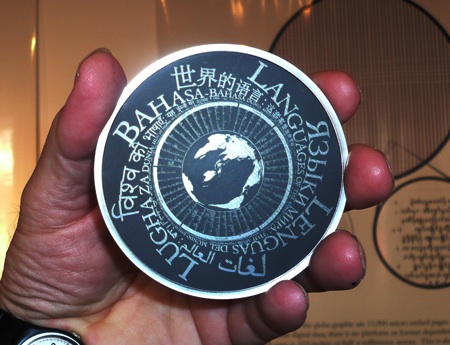My previous posts on two current “illuminated Bible” projects require some comparison and analysis. Despite their very different looks and aesthetic choices, the
St. John’s Bible and the
Bible Illuminated turn out to be quite similar in their inspirations, motivations, and goals. They both intentionally evoke and reproduce the tradition of medieval illuminated bibles in twenty-first century guise. Both employ modern aesthetic sensibilities, though in different registers—the Bible Illuminated uses cutting-edge mass-market sensibilities while the SJB aims more for art museum culture. Both projects aim to get more people reading the Bible, just as other recent
graphic-intensive bibles do, but both clearly also aim for an audience that is culturally sophisticated.
Several companion volumes issued by St. John’s publishing house, Liturgical Press, explain the motives behind the
SJB. Christopher Calderhead’s
Illuminating the Word: The Making of the Saint Johns Bible (Collegeville: Order of Saint Benedict, 2005) provides detailed descriptions of the calligraphers and their work, and also interviews with the major figures behind the project at St. John’s. Susan Sink’s
The Art of the Saint John’s Bible: A Reader’s Guide to Pentateuch, Psalms, Gospels, and Acts (Collegeville: Order of St. Benedict, 2007) instructs readers on using the SJB for devotional study and meditation.
Calderhead’s interviews reveal two different goals motivating the Abbey and University to embrace this project. The first is the traditional goal of Christian outreach, according to Abbot John Klassen and several others.
“He foresaw the Bible moving to exhibitions around the country, engaging people, especially the young, asking them to encounter the Scriptures in a new form” (p. 22).
The second is more internal to the Abbey and to the Benedictine tradition. Calderhead says Klassen
“saw The Saint John’s Bible as a way of sharing the Scriptures in a classic Benedictine way: to encourage lectio divina, the slow, meditative monastic method of reading the Bible, on a mass scale. That’s what he’d like to see Saint John’s do with its new Bible; that’s what he’d like to see happen in the broader world, when people see the book and pore over it” (ibid).
The Abbot is well aware of its iconic potential. He told Calderhead:
“‘It is a retrieval of the Catholic imagination with scripture. The Word becomes sacramental. It is not just a text. It is like the Eucharist: a visual image of the Word’” (p. 21).
Carol Marrin, director of the Bible project, echoed the Abbot in claiming that one of the project goals is to
“revive tradition. ... She explained: ‘Monasteries of the Middle Ages were places where books were made. In some periods of history they were the only centers of book production.’ ... The Saint John’s Bible revives the link between monastic communities and the hand-made book” (p. 28).
The website of
IlluminatedWorld, publisher of
The Bible Illuminated, denies a “religious agenda,” but that is quickly belied by the value judgments in the surrounding sentences. Its mission is to:
introduce today’s audience to a revolutionary contemporary Bible, one that encourages dialogue and is culturally relevant, readily accessible and easily digestible for any reader regardless of religious, economic, racial or social background.
Illuminated World does not support or endorse any specific religion. We have no religious agenda. It is simply meant to be a unique vehicle for reacquainting today’s reader with the most important historical text ever written and capture the greatest story ever told as no one has seen it in 2000 years.
Elsewhere, the culture of corporate advertising shapes the self-description: founder Dag Söderberg’s “vision from the beginning was to re-brand the Bible for a consumer audience but remain true to the text.”
Despite the tradition of medieval illuminated Bibles employed both rhetorically and in design elements (see
my previous post), the website critiques “traditional” Bibles and other “historical books.” The project founders “began pondering if the traditional format or design turned people off. They realized there was a huge opportunity to re-design or illuminate these types of old texts.”
So like the
SJB, the
Illuminated Bible uses striking visuals to gain more readers for the Christian Bible. Does it also fulfill more personal, internal goals for its designer(s)? The publicity is coy about personal motives, describing Söderberg as “a spiritual but not particularly religious individual.” Yet his biography—successful advertising executive who retires from the business and devotes himself to Bible publishing—suggests a personal engagement that the publicity refuses to make explicit. His hopes for others’ reactions to the project hint at a personal drive: “The goal is to drive an emotional reaction and get people to think, discuss and share. It’s meant to trigger bigger moral questions.”
It seems to me that these very contemporary productions,
the Saint Johns Bible and
the Bible Illuminated, therefore reproduce creatively not only the conceptual form of illuminated manuscripts but also their motivations. The medieval monks who labored over their parchments also aimed to bring fame and glory (if not readers) to the scripture as well as work out their own salvation in the process. Under other language and art, the goals and motivations remain the same.

































